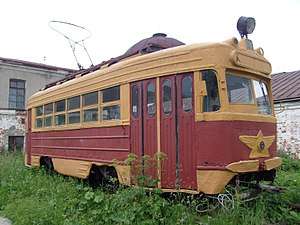KTM/KTP-1
KTM-1 is a Soviet-made two-axle tram with a body made of solid metal, while KTP-1 is a two-axle trailer car to intended to work under KTM-1 traction. It was the first Soviet-made tram to be originally single ended, as well as designated to work on looped (not dead-end) lines. Also, it was a first Soviet-made tram with wide four-segment folding doors and bigger passenger storage spaces. Doors were driven pneumatically.
| KTM/KTP-1 | |
|---|---|
 Tram-monument in Arkhangelsk | |
| Manufacturer | |
| Constructed | 1947-1961 |
| Number built | ≈2280 |
| Capacity | 16 seats |
| Specifications | |
| Train length | 10,200 mm (33 ft 6 in) / 10,230 mm (33 ft 7 in) |
| Width | 2,530 mm (8 ft 4 in) |
| Height | 3,060 mm (10 ft 0 in) |
| Doors | 4 |
| Maximum speed | 40 |
| Electric system(s) | 600 V |
| Bogies | 2 |
| Track gauge | 1,524 mm (5 ft) |
History
KTM/KTP1 developments began right after the end of World War II. These trams were intended to replace obsolete pre-war trams. KTM/KTP1 was a kind of transitional stage between pre-war and post-war tram developments. Unlike the majority of pre-war trams, the КТМ/КТП-1 featured a solid metal body. But, like pre-war trams, they were two-axle and intended to be used as motor-trailer pairs. Later on, people refused to use two-axle trams; and tram production changed so all new trams were equipped with bogies. And the articulated trams, as well as Multiple Unit Systems came into use, on segments with huge ridership.
The production
The production of experimental KTM/KTP1 trams began in December 1947 in a Tram Manufacturing Plant in Ust' Katavsk City. In the next year, the plant started serial production of the trams. Production lasted until 1961, when the plant switched to the production more modern KTM/KTP-2 trams.
Usage
The KTM/KTP1 worked in so many cities that it is easier to point the cities where these trams were not used! In Russian Federation these cities were Zlatoust, Kolomna, Kopejsk, Kursk, Leningrad, Noginsk, Smolensk, and Yekaterinburg.
KTM/KTP-1 retirement
KTM/KTP-1 trams started to be removed from passenger service by the middle of the 1970s. In Ukrainian cities of Zaparozh'e and Odessa, Ukraine, KTM/KTP1 were in service till 1986. Some of them were rebuilt into service trams.
Technical Features
The body of the tram is rigid (solid) and continuously welded of metal. The frame and the coating are the main carrying elements. Doors - single segment, from right side only (the tram was built as a one side). The tram was designed for a wide gauge tracks, as found in Russia (1,524 mm (5 ft)), however in Rostov-Na-Donu KTM/KTP-1 were rebuilt for European rail gauge (1,435 mm (4 ft 8 1⁄2 in)).
The motor tramcar was driven by fast DK-254А engines, with a power of 50 kW (67 hp) per each. Two step reductor was used as a power transmission from a traction motor to the leading wheel pair. In the rear wheel pair a two step reductor with a kardan of an automobile type was in use. The tram was driven using the fist-like controller МТ-22 or МТ-1. The tram collected electric power by a bugel', however in Rostov-na-Donu trolley poles were in use. The brakes, and doors were pneumatic. There was a special valve, which lead tram to full stop if a multiple unit was broken. The hand brake also existed.
Due to high use on some routes, three and four car tram couples were used. This was done since KTM/KTP1 trams were not intended to work as multiple traction systems. In these cases the motor circuits of two tramcars are combined into one, and everything was done as in 4-car units.
The low level of comfort is a major fault of the tram. The seats in trams were wooden. Since the car-base of the tram was not perfect, the tram squealed while making turns. Compressors also made much noise.
Due to external similarity sometimes it is possible to see an opinion about the similarity of КТМ-1 tram, and American-made PCC trolley. In reality, this similarity is only in external view. In difference of PCC trolleys, which had boogies, КТМ-1 was a double-axle tram. The control system of KTM-1 was different of PCC.